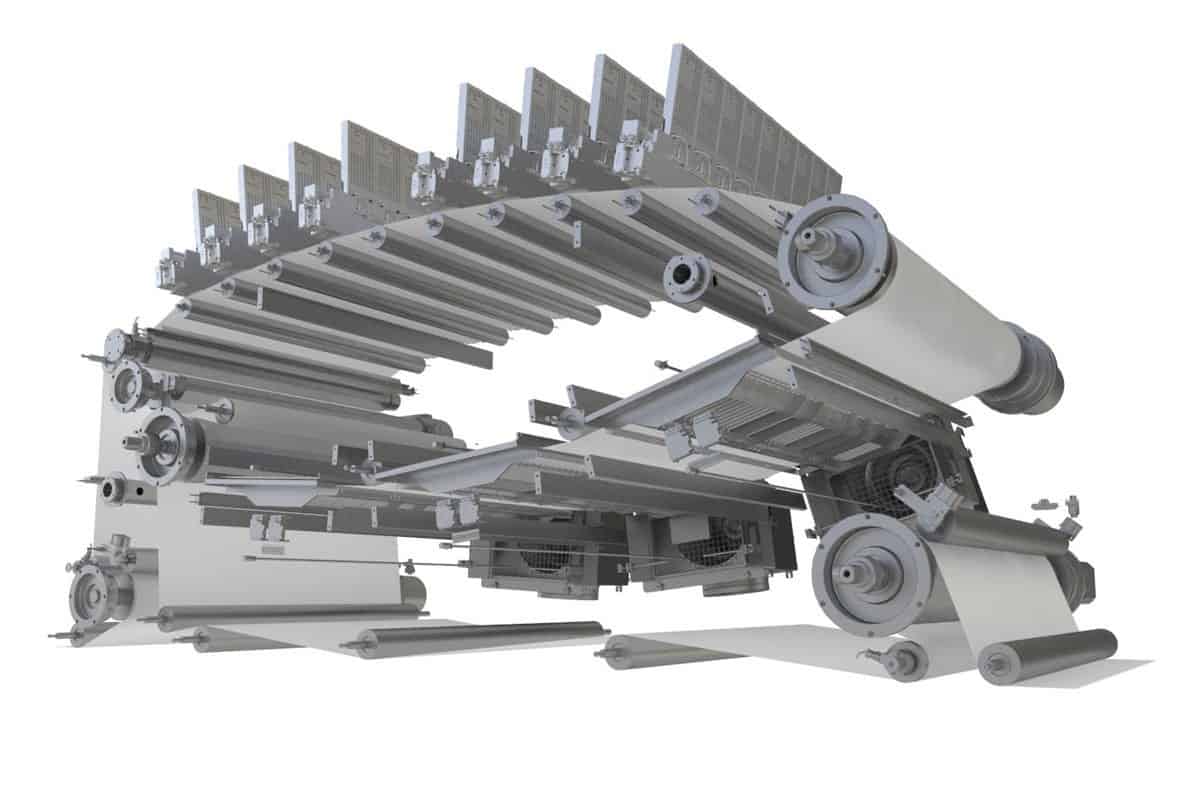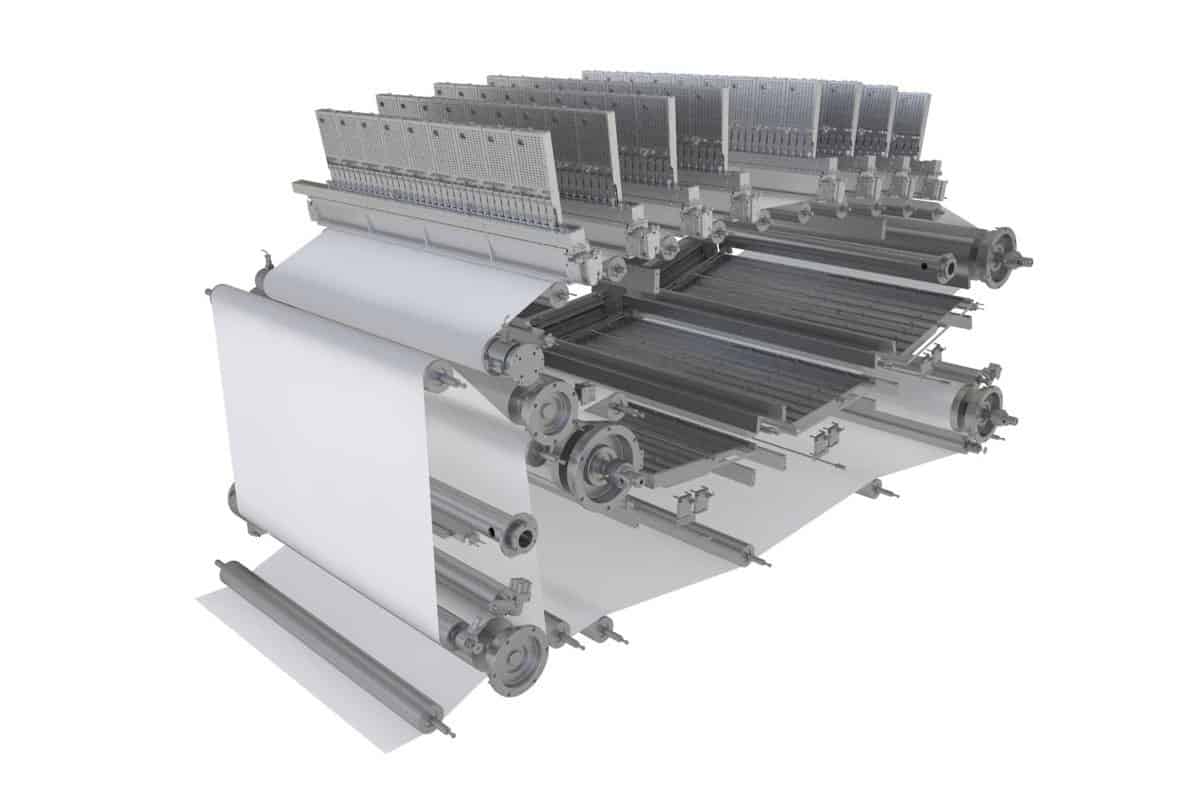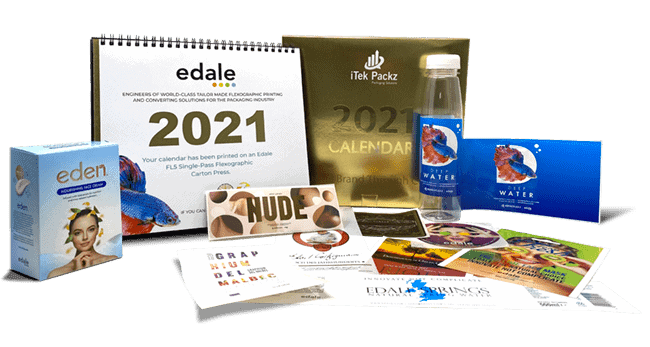Ink Jet Web Transport
We are proud of our proven 20 years of experience in designing and manufacturing high precision Ink Jet web transport systems combined with analogue converting solutions.
We have deep expertise in web-transport systems, moving material in a continuous multi-stop process, allowing you to deliver quality and consistency at scale.
Many of the projects we work on have never been attempted before or are for entirely new applications removed from standard print production.
We work with major engineering companies worldwide and offer custom design of web transport units.
And we are used to supporting our customers and providing solution for often demanding unusual requirements.
Here is a guide to help you navigate your way through factors to consider.

Print quality
Print quality is determined, especially in inkjet, by the resolution of the print in digital pixels per inch (DPI). But this is not the only factor; a fine print is only possible if the dots' size and position can be tightly controlled.

The inkjet head
The inkjet head itself plays its part in jetting a particular droplet size at the right time. If the substrate passing underneath the droplet is not in the determined position, then all is lost. Ensuring the substrate is in the correct position is a function of the web transport and, more specifically, the web transport's ability to minimise the deviation of the substrate as it passes through the machine.

The web transport
The web transport acts as the structure and base machine, so it is important that it is free from vibrations, is temperature-controlled, is stable and reliable and has suitable pre-inkjet web treatment processing. Finally, it must be properly integrated to the machine's inkjet to ensure accuracy between the systems.

Accurate cross positioning
The need for accurate cross positioning of the substrate requires a highly accurate and aligned machine with precision elements. The fine tension control and interfacing with the inkjet require sophisticated servo motor and drive technology working on a virtual line shaft to remove all mechanical inaccuracies.

The ink types, coat weights and running speeds
The ink types, coat weights and running speeds all influence the design and lead to a fully integrated end solution. The product specification and the type of substrates being processed can influence both the web transport design itself, requiring different web handling techniques, different drying technology and solutions at vastly different web widths. This requires an extensive catalogue of modular components designed at all widths.

The specification
The specification also determines any in-line hybrid solutions that may be required to deliver a product, such as flexo or die-cutting. At different widths and speeds, this too requires a great catalogue of designs and the ability to integrate into a final solution.

Inkjet presses
Inkjet presses are being marketed towards short-run, easy operation, fast set-up and not requiring the infrastructure of a conventional analogue printing press.
MOBILE VERSION STARTS HERE

Print quality
Print quality is determined, especially in inkjet, by the resolution of the print in digital pixels per inch (DPI). But this is not the only factor; a fine print is only possible if the dots' size and position can be tightly controlled.

The inkjet head
The inkjet head itself plays its part in jetting a particular droplet size at the right time. If the substrate passing underneath the droplet is not in the determined position, then all is lost. Ensuring the substrate is in the correct position is a function of the web transport and, more specifically, the web transport's ability to minimise the deviation of the substrate as it passes through the machine.

The web transport
The web transport acts as the structure and base machine, so it is important that it is free from vibrations, is temperature-controlled, is stable and reliable and has suitable pre-inkjet web treatment processing. Finally, it must be properly integrated to the machine's inkjet to ensure accuracy between the systems.

Accurate cross positioning
The need for accurate cross positioning of the substrate requires a highly accurate and aligned machine with precision elements. The fine tension control and interfacing with the inkjet require sophisticated servo motor and drive technology working on a virtual line shaft to remove all mechanical inaccuracies.

The ink types, coat weights and running speeds
The ink types, coat weights and running speeds all influence the design and lead to a fully integrated end solution.
The product specification and the type of substrates being processed can influence both the web transport design itself, requiring different web handling techniques, different drying technology and solutions at vastly different web widths. This requires an extensive catalogue of modular components designed at all widths.

The specification
The specification also determines any in-line hybrid solutions that may be required to deliver a product, such as flexo or die-cutting. At different widths and speeds, this too requires a great catalogue of designs and the ability to integrate into a final solution.

Inkjet presses
Inkjet presses are being marketed towards short-run, easy operation, fast set-up and not requiring the infrastructure of a conventional analogue printing press.
MOBILE VERSION ENDS HERE
We have to forget about the big print factories full of skilled and experienced painters.And think about more of a lab environment, where anyone can load a job and print.
This leads us to a press that must be fully integrated into a small footprint with levels of automation that set the job up and guide the operator through a determined workflow.
Specifically, inkjet press configurations require:
- Easy to use unwinder units with accurate tension control
- Web handling and treatment modules to suit the web width and the specific product with robust technologies for a frequent job and material changes
- Highly accurate digital module with components that have virtually zero mechanical inaccuracies, assembled with supreme precision and designed to be robust and stable.
- Interfacing and housing all the components of the inkjet unit itself. Drive and motor technology with multiple tension conditioning stages to deliver the best possible web control and encoder technology to relay this to the inkjet.
- Low inertia components to ensure minimal tension disturbances on the substrate.
- Zero gears and couplings to deliver perfect drive as determined by the tightly controlled servo motion control.
- Calculated design to ensure stability at high speeds and with high energy heat sources, ensuring control of the machine precision in a range of operating conditions.
- Fully integrated design to ensure the machine is suitable for installation in high-end environments and meeting all safety standards
- A huge catalogue of complimentary press technologies that fully integrate with the web transport, AiiR automation on flexos, semi-rotary cutting, rewinding, delivery systems.
Experience the difference Edale can make
Whilst current restrictions can make it difficult to travel, we don’t want our customers, partners and collaborators to miss out. We have been running regular Virtual Tours of our facilities and also for demonstrations.
If you are considering buying from us, or interested in some form of commercial partnership or simply want to find out more, please drop us a line using the form opposite and we will be in contact shortly.



